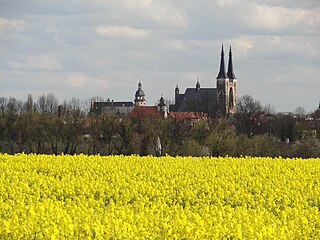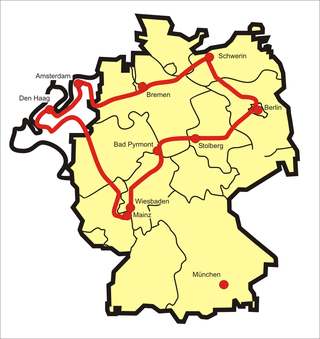
Wernigerode is a town in the district of Harz, Saxony-Anhalt, Germany. Until 2007, it was the capital of the district of Wernigerode. Its population was 32,181 in 2020.

Köthen ( ) is a town in Germany. It is the capital of the district of Anhalt-Bitterfeld in Saxony-Anhalt, about 30 km (19 mi) north of Halle.

Ballenstedt is a town in the Harz district, in the German state of Saxony-Anhalt.

Reinhardsbrunn in Friedrichroda near Gotha, in the German state of Thuringia, is the site of a formerly prominent Benedictine abbey, the house monastery of the Ludovingian Landgraves of Thuringia abbey extant between 1085 and 1525. Later used as an administrative seat by the Ernestine dukes of Saxony, the property was turned into a castle and park erected by the Dukes of Saxe-Coburg and Gotha from 1827.

A burgstall is a German term referring to a castle of which so little is left that its appearance cannot effectively be reconstructed. It has no direct equivalent in English, but may be loosely translated as "castle site". Variations in the literature include Burgstelle, Altburgstelle, die Burgställe (plural), Burgstähl (archaic) or abgegangene Burg. In German castle studies, a burgstall is a castle that has effectively been levelled, whereas a "ruin" (Ruine) still has recognisable remnants of the original castle above the level of the ground.

Mansfeld Castle is a castle in the region of Mansfeld Land in Saxony-Anhalt, Germany. The castle, which is surrounded by forest, stands on top of a large rock overlooking the town of Mansfeld. The Late Gothic church of the castle, as well as the ruins, moats and the remains of the battlements from the time of the old fortress make Mansfeld castle a popular attraction. Martin Luther often visited the castle, as his parents lived in Mansfeld. His father worked in the local copper mine, while Luther himself attended the school of Mansfeld.

Stolberg is a town and a former municipality in the district of Mansfeld-Südharz, in the German State of Saxony-Anhalt, Germany. It is situated in the southern part of the Harz mountains, about 27 kilometres (17 mi) west of Sangerhausen, and 13 km (8.1 mi) northeast of Nordhausen. Since 1 September 2010, it has been part of the municipality of Südharz.

Thallwitz is a municipality in the Leipzig district in Saxony, Germany.

The Moritzburg is a fortified castle in Halle (Saale), Germany. The cornerstone of what would later become the residence of the Archbishops of Magdeburg was laid in 1484; the castle was built in the style of the Early Renaissance.

Wernigerode Castle is a schloss located in the Harz mountains above the town of Wernigerode in Saxony-Anhalt, Germany. The present-day building, finished in the late 19th century, is similar in style to Schloss Neuschwanstein, though its foundations are much older and have been reconstructed several times. Wernigerode Castle was first built at the beginning of the 12th century (1110-1120) as a Romanesque architecture medieval fortress for German emperors to have a secure spot to stop during their hunting trips to the Harz. Few of these medieval walls and foundation remain today. At the end of the 15th century the castle was enlarged in a Gothic architecture style, with large arched windows. During the 16th century, it was rebuilt as a Renaissance fortress. A spiral staircase tower still remains intact today.

Drübeck Abbey is a former Benedictine monastery for nuns in Drübeck on the northern edge of the Harz in the German state of Saxony-Anhalt. Today it is a conference venue for the Evangelical Church of the Church Province of Saxony with an educational-theological institute and pastoral centre.

Heinrichsberg Castle is a ruin north of Mägdesprung in the borough of Harzgerode in central Germany. It is not far from the B 185 federal road in the district of Harz in the state of Saxony-Anhalt.

Ilsenburg House stands in the town of Ilsenburg (Harz) in the German state of Saxony-Anhalt and was given its present appearance in the 2nd half of the 19th century. The structure was built from 1860 onwards on the west and north sides of the Romanesque monastery of Ilsenburg Abbey. The stately home, designed in the Neo-Romanesque style, was the seat of the princes of Stolberg-Wernigerode until 1945. Since 2005, it has been owned by the Ilsenburg Abbey Foundation.

The Orange Route is a holiday route, that runs from Amsterdam in the Netherlands through North and Central Germany and returns to Amsterdam. It is 2,400 kilometres long and crosses the Netherlands and nine of German federated states. The Orange Route runs through towns and regions that linked the House of Orange-Nassau for centuries.

Zerbst Castle in the town of Zerbst, Saxony-Anhalt, Germany was the residence of the Princes of Anhalt-Zerbst from the late 17th century until the line died out in 1793. It later served as a museum and archive. The building was severely damaged by bombs during the last weeks of World War II and largely demolished afterwards.

The Ilsestein is a prominent granite rock formation near the town of Ilsenburg in the Harz mountains of central Germany. Offering a scenic view over the Ilse valley to the Brocken massif, the highest mountain of the range, it is today a popular tourist destination.

Schloss Köthen is a palace (schloss) in Köthen (Anhalt), Germany. Begun as a castle, it was protected by a moat. It was the residence of the Princes and Dukes of Anhalt from 1244 to 1847, and now belongs to a foundation for the preservation of sites in Saxony-Anhalt.

Callenberg Castle is a schloss on a wooded hill in Beiersdorf, an Ortsteil of Coburg, Germany, 6 kilometres (3.7 mi) from the town centre. It was a hunting lodge and summer residence and has long been the principal residence of the House of Saxe-Coburg and Gotha. It is currently owned by Andreas, Prince of Saxe-Coburg and Gotha, who created the Ducal Saxe-Coburg and Gotha House Order. A large and architecturally important family chapel is contained within.

Schloss Wolfenbüttel is a castle in Wolfenbüttel, Lower Saxony, Germany. An extensive four-wing complex, it originated as a moated castle (Wasserburg). It is the second-largest surviving schloss in Lower Saxony and served as the main residence of the rulers of the Principality of Brunswick-Wolfenbüttel from 1432 to 1753. It now houses a gymnasium secondary school, the Federal Academy of Arts Education, and a museum with its historic rooms on display. Its immediate vicinity is home to several historically significant buildings including the Herzog August Bibliothek, the Lessinghaus, the Zeughaus, and the Kleines Schloss.

The Dessau Palace in Dessau in the German state of Saxony-Anhalt was a princely palace which mostly served as the main residence of the princes of Anhalt-Dessau and later the Dukes of Anhalt. The palace was one of the first renaissance buildings in the middle of Germany. Today, there is only one wing remaining, the Johannbau, which offers room to the City History Museum of Dessau.





















